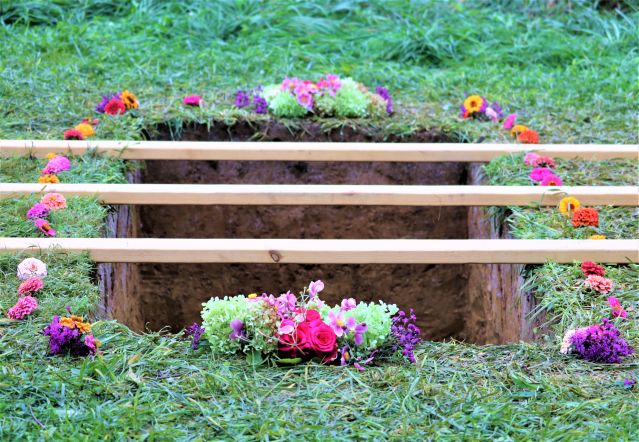Grief
Beauty and Grief: The Artists of Green Burial
Who they are, what they do, and how they help.
Posted June 1, 2023 Reviewed by Kaja Perina
Like most activities that are performed with skill and elegance, natural burial is an art, and the artists are many and varied. They play critical roles throughout the entire implementation of a burial service from start to finish to make the experience as supportive and beautiful as possible for those who have lost a loved one. Beauty heals, and the personalized attention to detail at a burial is captivating to everyone in attendance and lays the aesthetic groundwork for healing from a loss. Friends and family members gain peace and comfort from the fact that their loved one is laid to rest, quite literally, on a bed of roses.
In 2019, the World Health Organization released a report asking the question: “What is the evidence on the role of the arts in improving health and well-being?” The report “found evidence from a wide variety of disciplinary approaches and methodologies for the potential value of the arts in contributing to core determinants of health; playing a critical role in health promotion; helping to prevent the onset of mental illness and age-related physical decline; supporting the treatment or management of mental illness, noncommunicable diseases and neurological disorders; and assisting in acute and end-of-life care.”
For the artists and beautifiers involved in a natural burial, it is sacred work. A successful burial service requires devoted time and energy by a collection of dedicated people who are passionate about this endeavor, and who are often in large part, volunteers. Lucinda Herring in her book Reimagining Death: Stories and Wisdom for Home Funerals and Green Burials describes the personal and artistic touch involved in green burial this way: “each gesture was the response of someone’s soul—their heart wish to soothe and enliven the wan, lifeless hues and waxy textures of the dead. I saw that such offerings also helped people feel more needed and useful, more connected to the beauty unfolding there.”
To feel more needed, useful, and connected to the beauty of ritual and the interwoven web of life is at the heart of every natural burial service. So, who are the artists of green burial?
The Gravediggers
Natural burial graves are typically dug by hand. For a body burial, this can take anywhere from six to eight hours depending on the weather conditions and how many gravediggers are at work. In the end, what is created is a roughly forty-two inch deep, carefully measured grave that is squared and sculpted with great care and precision. It is a sacred container with no concrete vault or metal liner to separate the body from its earthly home. It is akin to the artistry of any other type of sculpted container except the material is soil and the artist’s tools are shovels of various shapes and sizes, spud bars, and a pick-axe. When the grave looks cleanly carved and alluring rather than frightening, it is ready.

The Grave Decorators
The grave decorators are the individuals who arrive at least one hour before the burial service to place a layer of wood chips, flowers, and evergreen boughs in the bottom of the grave and then adorn the perimeter outside the grave with additional greens, leaves, dried grasses, and flowers. Whether the grave is decorated with simplicity or elaborate floral work, it is a site to behold for those attending the burial. If the grave decorators are aware of the decedent’s favorite color or flower, every effort is made to include those when preparing the gravesite. Each grave is adorned differently. The bottom of the grave might be designed with a grave mandala, sprinkled with rose petals, or decorated (using biomass) with a personalized image that is meaningful for the person whose body will call the grave home. After the grave is thoughtfully floral-framed and softened with evergreen clippings, it will radiate with love.
Casketweavers and Shroudmakers
Caskets used in a natural burial service are made of biodegradable materials such as willow, seagrass, bamboo, or wicker. Each stalk of bamboo is grown, harvested, prepared, and weaved by skilled artists and craftspeople who prioritize ecological sustainability at the core of their work. According to the Funerary Artisans Collective, “toxic glues, finishes, metal hardware, rubber, synthetic textiles—anything that does not biodegrade naturally on Nature's timeline—are prohibited.” Similarly, shroudmakers use all natural fibers such as cotton, wool, or silk and plant-based, non-toxic dyes for color.
What these talented artisans do is create containers that reflect the values of the person who has died. If you have ever attended a funeral or burial and were left with the feeling that the service seemed “all wrong” for the person who died, then you know how important it is to get your death plans in order and to document your preferences. If a large, glossy, corporate-owned, factory-made casket does not accurately represent the deceased, it will only make the grieving process more difficult.
The Photographers
We’ve all heard of wedding photographers, but how about funeral photographers? Not all families are comfortable with photographs being taken at a funeral, but for those who are, the images are powerful whether taken by family members, friends, or a professional photographer. Natural burial services are also sometimes filmed and recorded for future viewing. It’s the personalized and heartfelt artistic beauty of these services that makes them worth capturing on film. When death is approached with the same love and reverence as any other major life event, the fear of embracing its images and preserving its memory falls away.
Family and Friends
Natural burial services are family directed, so the most important artists in a ceremony are the friends and family members of the deceased. They often bring to the service their own letters, poems, stories, music, and flowers that are lovingly placed on top of the body before it is lowered into the grave. Flowers are tucked into the straps of a shrouded body, or a colorful floral spray is carefully centered on top of a hand-woven casket. Additional flowers are then used to adorn the mound into a gorgeous oval bouquet after the friends and family fill the grave.

Art, in all of its forms, empowers us with mediums for self-expression. It helps us to work through our loss by transforming grief into something outside of ourselves so it can be processed and released, even if only to a small degree. It is not unusual for a natural burial service to begin with tears, but to end with laughter. That emotional evolution is made possible by the great love and care that is sewn within the fabric of every burial service, and also by the beauty that abounds from the grave, from the mound, and from the body itself. At the end of a service, after friends and family members slowly leave the grave and make their way back to their vehicles, what remains is not only a stunningly mounded grave that represents ecologically sustainable death care, but also an earthly rendering of love, sweat, tears, beauty, heart, and soul.
References
Herring, Lucinda. 2019. Reimagining Death: Stories and Wisdom for Home Funerals and Green Burials. North Atlantic Books.




